Understanding the Stability of Passenger Vehicles Exposed to Water Flows through 3D CFD Modelling
Abstract
:1. Introduction
2. Methodology
2.1. Governing Equations
2.2. Meshing and Geometry
2.3. Numerical Setup
3. Results and Discussion
3.1. Recognition of Sliding Instability Numerically
3.2. Streamlines Distribution
3.3. Hydrodynamic Forces
3.3.1. Horizontal Force, FH
3.3.2. Vertical Force, FV
3.3.3. Frictional Force, FR
3.3.4. Drag Coefficient, CD
4. Validation of Results
4.1. Australian Rainfall and Runoff (AR&R 2011) [32]
4.2. Martínez-Gomariz et al. (2017) [13]
4.3. Al-Qadami et al. (2022) [33]
5. Conclusions
- For the tested vehicle model, it was noticed that the floating instability mode occurred once the upward pushing forces exceeded the vehicle weight as expected. On the other hand, the sliding instability mode occurred once the horizontal drag force exceeded the frictional resistance between the tires and the ground surface.
- The sliding instability mode was observed in four cases with the depth × velocity threshold function values of 0.41, 0.40, 0.49, and 0.69 m2/s, while the floating instability mode was observed in three cases when water depth reached more than 0.38 m.
- The threshold value of the depth × velocity function was found to be 0.36 m2/s, at which the vehicle was considered stable if m2/s, while the vehicle lost its stability if m2/s.
- The floating instability mode was common when the flow was subcritical, while the sliding stability mode was common when the flow was supercritical.
- Both instability modes could occur at the same time, i.e., the vehicle floated first and then was washed away within the flow direction.
- The drag force was mainly influenced by the flow velocity while the buoyancy force was mainly affected by the water depth at the vehicle vicinity.
- The drag coefficient was observed to be more than 1 when the flow was subcritical, but the value was reduced to less than 1 when the flow was supercritical.
- By employing six degrees of freedom and fully coupled techniques, the vehicle center of mass could be detected at each time step. This helped to accurately know whether the vehicle was stable or not.
- The validation process showed that the obtained numerical results were logical, and the proposed numerical framework was reliable in predicting the stability limits of any other vehicles.
Author Contributions
Funding
Institutional Review Board Statement
Informed Consent Statement
Data Availability Statement
Acknowledgments
Conflicts of Interest
Nomenclature
| VF | fluid volume function |
| ρ | fluid density (kg/m3) |
| t | time (s) |
| u | velocity components in the coordinate directions of x |
| v | velocity components in the coordinate directions of y |
| w | velocity components in the coordinate directions of z |
| RSOR | density source term |
| Ax | fractional area open to flow in the x direction |
| Ay | fractional area open to flow in the y direction |
| Az | fractional area open to flow in the z direction |
| Gx | body acceleration in x coordinate |
| Gy | body acceleration in y coordinate |
| Gz | body acceleration in z coordinate |
| fx | viscous accelerations in the x direction |
| fy | viscous accelerations in the y direction |
| fz | viscous accelerations in the z direction |
| P | pressure (Pa) |
| GT | buoyancy production term |
| ϵT | energy dissipation rate |
| PT | turbulence kinetic energy |
| DiffKT | diffusion term |
| CDIS1 | dimensionless user-adjustable parameters |
| CDIS2 | dimensionless user-adjustable parameters |
| CDIS3 | dimensionless user-adjustable parameters |
| hb | buoyancy depth |
| Mc | vehicle weight |
| Lc | vehicle length |
| bc | vehicle width |
| GC | ground clearance, |
| PA | vehicle plane area |
| μ | friction coefficient |
| FR | frictional force |
| FW | vehicle weight |
| FV | upward pushing force (vertical force) |
| CD | drag coefficient |
| FH | drag force |
| AD | area projected normally to the incoming flow |
| H | water depth |
References
- Enríquez-de-Salamanca, Á. Victims crossing overflowing watercourses with vehicles in Spain. J. Flood Risk Manag. 2020, 13, e12645. [Google Scholar] [CrossRef]
- Ashley, S.T.; Ashley, W.S. Flood fatalities in the United States. J. Appl. Meteorol. Climatol. 2008, 47, 805–818. [Google Scholar] [CrossRef]
- Drobot, S.D.; Benight, C.; Gruntfest, E.C. Risk factors for driving into flooded roads. Environ. Hazards 2007, 7, 227–234. [Google Scholar] [CrossRef]
- Diakakis, M.; Deligiannakis, G. Vehicle-related flood fatalities in Greece. Environ. Hazards 2013, 12, 278–290. [Google Scholar] [CrossRef]
- Petrucci, O.; Salvati, P.; Aceto, L.; Bianchi, C.; Pasqua, A.A.; Rossi, M.; Guzzetti, F. The vulnerability of people to damaging hydrogeological events in the Calabria Region (Southern Italy). Int. J. Environ. Res. Public Health 2018, 15, 48. [Google Scholar] [CrossRef] [PubMed]
- Petrucci, O.; Papagiannaki, K.; Aceto, L.; Boissier, L.; Kotroni, V.; Grimalt, M.; Llasat, M.C.; Llasat-Botija, M.; Rosselló, J.; Pasqua, A.A. MEFF: The database of Mediterranean flood fatalities (1980 to 2015). J. Flood Risk Manag. 2019, 12, e12461. [Google Scholar] [CrossRef]
- Ahmed, M.A.; Haynes, K.; Taylor, M. Vehicle-related flood fatalities in Australia, 2001–2017. J. Flood Risk Manag. 2020, 13, e12616. [Google Scholar] [CrossRef]
- Bonham, A.J.; Hattersley, R.T. Low level causeways [Technical Report 100]; The University of New South Wales, Water Research Laboratory: Sydney, Australia, 1967. [Google Scholar]
- Smith, G.P.; Modra, B.D.; Felder, S. Full-scale testing of stability curves for vehicles in flood waters. J. Flood Risk Manag. 2019, 12, e12527. [Google Scholar] [CrossRef]
- Gordon, A.D.; Stone, P.B. Car Stability on Road Floodways. National Capital Development Commission; Report; National Library of Australia: Parkes, Australia, 1973. [Google Scholar]
- Shand, T.D.; Smith, G.P.; Cox, R.J.; Blacka, M. Development of Appropriate Criteria for the Safety and Stability of Persons and Vehicles in Floods. In Proceedings of the 34th World Congress of the International Association for Hydro-Environment Research and Engineering: 33rd Hydrology and Water Resources Symposium and 10th Conference on Hydraulics in Water Engineering, Brisbane, Australia, 26 June–1 July 2011. [Google Scholar]
- Kramer, M.; Terheiden, K.; Wieprecht, S. Safety criteria for the trafficability of inundated roads in urban floodings. Int. J. Disaster Risk Reduct. 2016, 17, 77–84. [Google Scholar] [CrossRef]
- Martínez-Gomariz, E.; Gómez, M.; Russo, B.; Djordjević, S. A new experiments-based methodology to define the stability threshold for any vehicle exposed to flooding. Urban Water J. 2017, 14, 930–939. [Google Scholar] [CrossRef]
- Shu, C.; Xia, J.; Falconer, R.A.; Lin, B. Incipient velocity for partially submerged vehicles in floodwaters. J. Hydraul. Res. 2011, 49, 709–717. [Google Scholar] [CrossRef]
- Teo, F.Y.; Xia, J.; Falconer, R.A.; Lin, B. Experimental studies on the interaction between vehicles and floodplain flows. Int. J. River Basin Manag. 2012, 10, 149–160. [Google Scholar] [CrossRef]
- Al-Qadami, E.H.H.; Razi, M.A.M.; Damanik, W.S.; Mustaffa, Z.; Martinez-Gomariz, E.; Teo, F.Y.; Saeed, A.A.H. 3-Dimensional Numerical Study on the Critical Orientation of the Flooded Passenger Vehicles. Eng. Lett. 2023, 31, 961–968. [Google Scholar]
- Xia, J.; Falconer, R.; Lin, B.; Tan, G. Numerical assessment of flood hazard risk to people and vehicles in flash floods. Environ. Model. Softw. 2011, 26, 987–998. [Google Scholar] [CrossRef]
- Arrighi, C.; Alcèrreca-huerta, J.C.; Oumeraci, H.; Castelli, F. Drag and lift contribution to the incipient motion of partly submerged flooded vehicles. J. Fluids Struct. 2015, 57, 170–184. [Google Scholar] [CrossRef]
- Albano, R.; Sole, A.; Mirauda, D.; Adamowski, J. Modelling large floating bodies in urban area flash-floods via a Smoothed Particle Hydrodynamics model. J. Hydrol. 2016, 541, 344–358. [Google Scholar] [CrossRef]
- Amicarelli, A.; Albano, R.; Mirauda, D.; Agate, G.; Sole, A.; Guandalini, R. A Smoothed Particle Hydrodynamics model for 3D solid body transport in free surface flows. Comput. Fluids 2015, 116, 205–228. [Google Scholar] [CrossRef]
- Gómez, M.; Martínez, E.; Russo, B. Experimental and Numerical Study of Stability of Vehicles Exposed to Flooding. In Advances in Hydroinformatics; Springer: Berlin/Heidelberg, Germany, 2018; pp. 595–605. [Google Scholar]
- Martínez-Gomariz, E.; Gómez, M.; Russo, B. Estabilidad de vehículos frente a inundaciones: Estudio numérico-experimental. Ribagua 2019, 6, 123–137. [Google Scholar] [CrossRef]
- Al-Qadami, E.H.H.; Mustaffa, Z.; Al-Atroush, M.E.; Martinez-Gomariz, E.; Teo, F.Y.; El-Husseini, Y. A numerical approach to understand the responses of passenger vehicles moving through floodwaters. J. Flood Risk Manag. 2022, 15, e12828. [Google Scholar] [CrossRef]
- Al-Qadami, E.H.H.; Mustaffa, Z.; Martínez-Gomariz, E.; Yusof, K.W.; Abdurrasheed, A.S.; Shah, S.M.H. Numerical Simulation to Assess Floating Instability of Small Passenger Vehicle Under Sub-critical Flow. In Proceedings of the International Conference on Civil, Offshore and Environmental Engineering, Dubai, United Arab Emirates, 20–21 December 2021; Springer: Berlin/Heidelberg, Germany, 2021; pp. 258–265. [Google Scholar]
- Mustaffa, Z.; Al-Qadami, E.H.H.; Shah, S.M.H.; Yusof, K.W. Impact and Mitigation Strategies for Flash Floods Occurrence towards Vehicle Instabilities. In Flood Impact Mitigation and Resilience Enhancement; IntechOpen: London, UK, 2020. [Google Scholar]
- Abdurrasheed, S.; Wan Yusof, K.; Hamid Hussein Alqadami, E.; Takaijudin, H.; Muhammad, M.M.; Sholagberu, A.T.; Zainalfikry, M.K.; Osman, M.; Shihab Patel, M. Modelling of flow parameters through subsurface drainage modules for application in BIOECODS. Water 2019, 11, 1823. [Google Scholar] [CrossRef]
- Maldar, N.R.; Ng, C.Y.; Ean, L.W.; Oguz, E.; Fitriadhy, A.; Kang, H.S. A Comparative Study on the Performance of a Horizontal Axis Ocean Current Turbine Considering Deflector and Operating Depths. Sustainability 2020, 12, 3333. [Google Scholar] [CrossRef]
- Wahyudi, B.; Adiwidodo, S. The influence of moving deflector angle to positive torque on the hydrokinetic cross flow savonius vertical axis turbine. Int. Energy J. 2017, 17, 11–21. [Google Scholar]
- Barkhudarov, M.R. Lagrangian VOF Advection method for FLOW-3D. Flow Sci. Inc. 2004, 1. Available online: https://citeseerx.ist.psu.edu/document?repid=rep1&type=pdf&doi=693db5d4396e86fdf9850e282563950211a1d749 (accessed on 20 June 2023).
- Maguire, A.E. Hydrodynamics, Control and Numerical Modelling of Absorbing Wavemakers. Ph.D. Thesis, University of Edinburgh, Edinburgh, UK, 2011. [Google Scholar]
- Abu-Zidan, Y.; Mendis, P.; Gunawardena, T. Optimising the computational domain size in CFD simulations of tall buildings. Heliyon 2021, 7, e06723. [Google Scholar] [CrossRef] [PubMed]
- Shand, T.D.; Cox, R.J.; Blacka, M.J.; Smith, G.P. Australian Rainfall and Runoff Project 10: Appropriate Safety Criteria for Vehicles–Literature Review. Commonw. Aust. Geoscience Aust. 2011, 2, 1–29. [Google Scholar]
- Al-Qadami, E.H.H.; Mustaffa, Z.; Shah, S.M.H.; Matínez-Gomariz, E.; Yusof, K.W. Full-scale experimental investigations on the response of a flooded passenger vehicle under subcritical conditions. Nat. Hazards 2022, 110, 325–348. [Google Scholar] [CrossRef]
Disclaimer/Publisher’s Note: The statements, opinions, and data contained in all publications are solely those of the individual author(s) and contributor(s) and not of MDPI and/or the editor(s). MDPI and/or the editor(s) disclaim responsibility for any injury to people or property resulting from any ideas, methods, instructions, or products referred to in the content. |
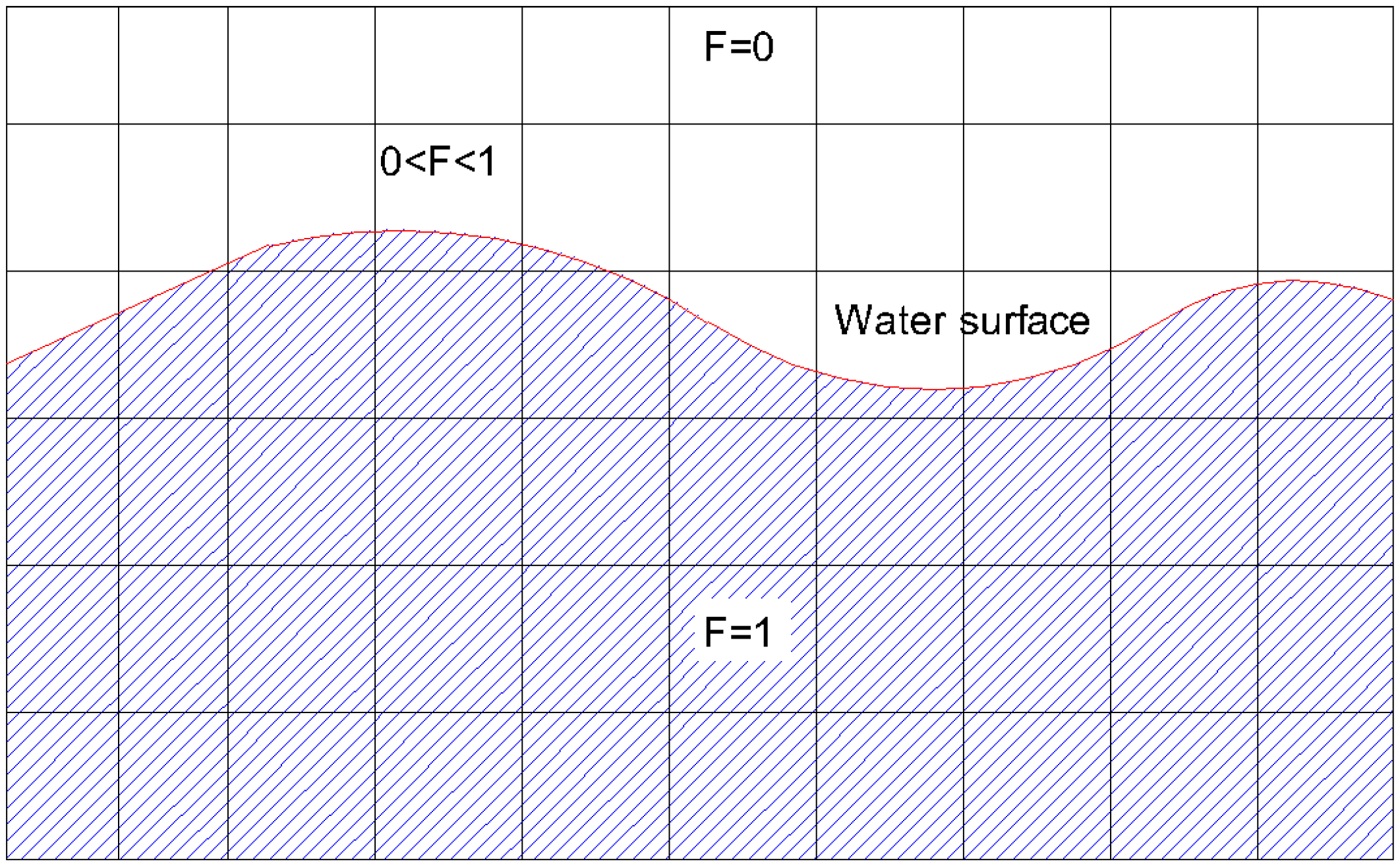
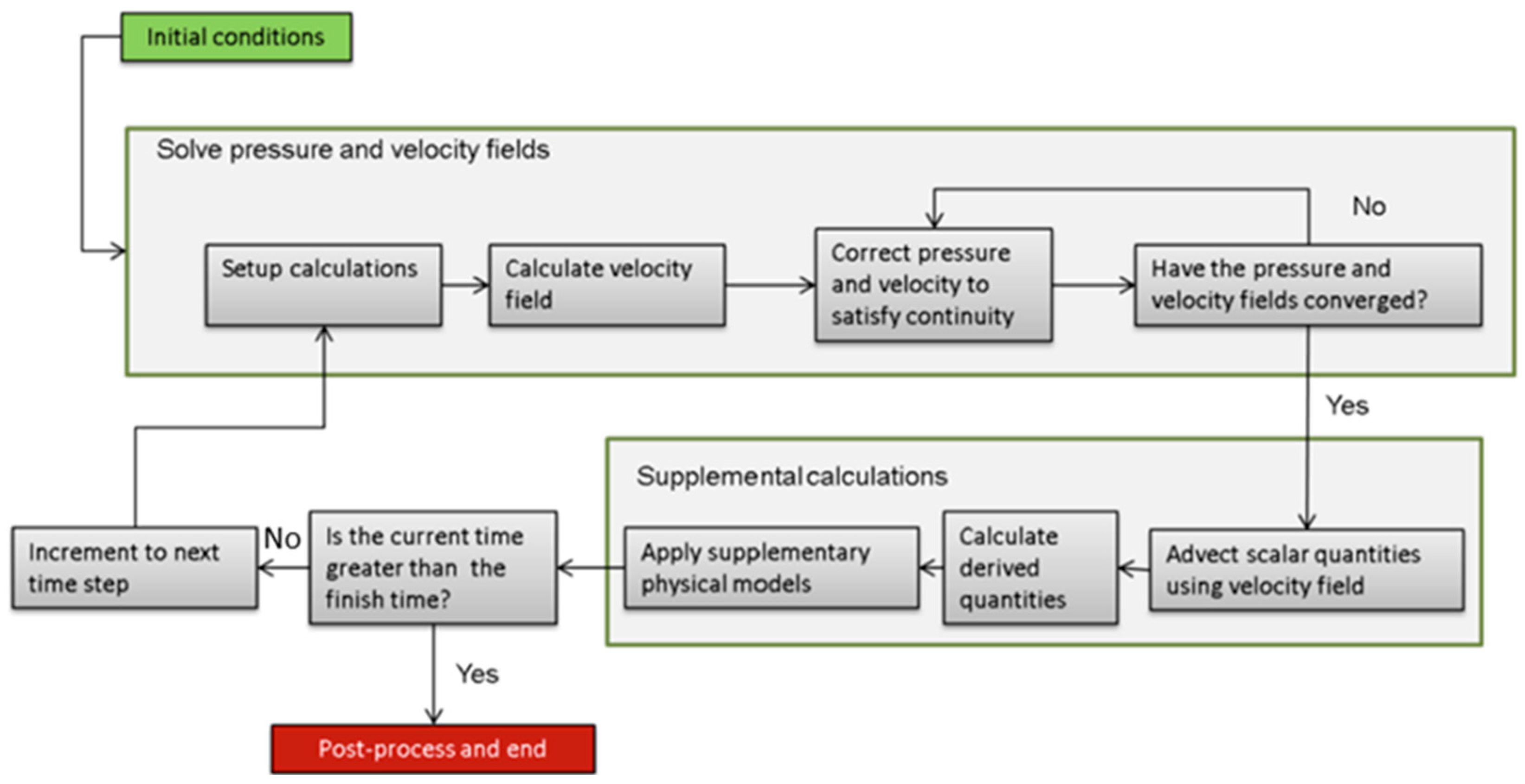




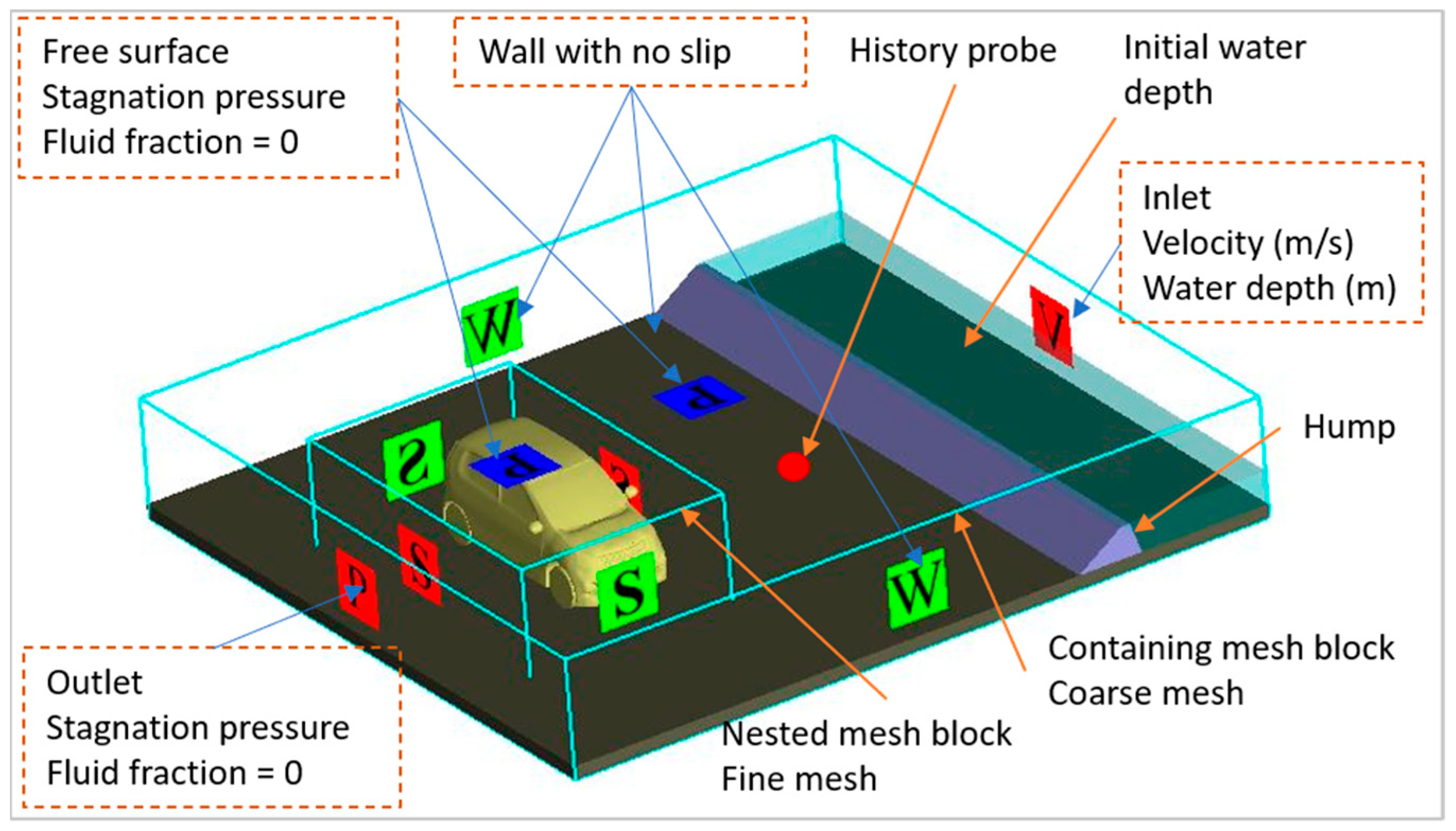


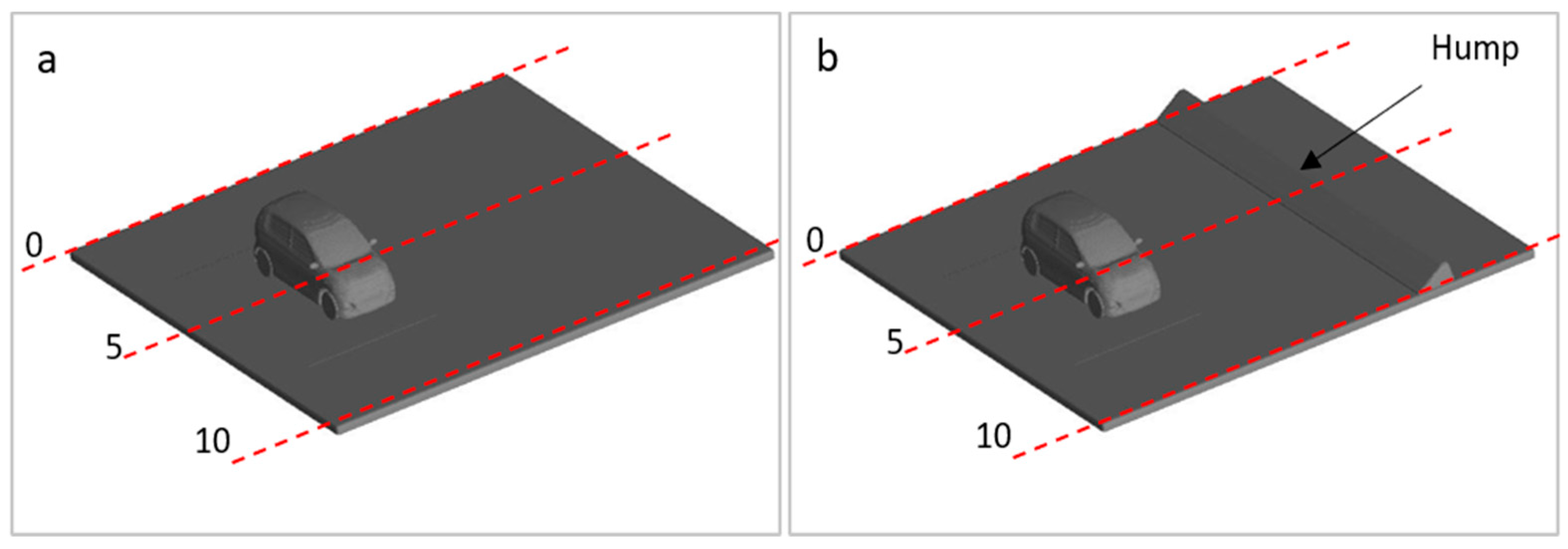


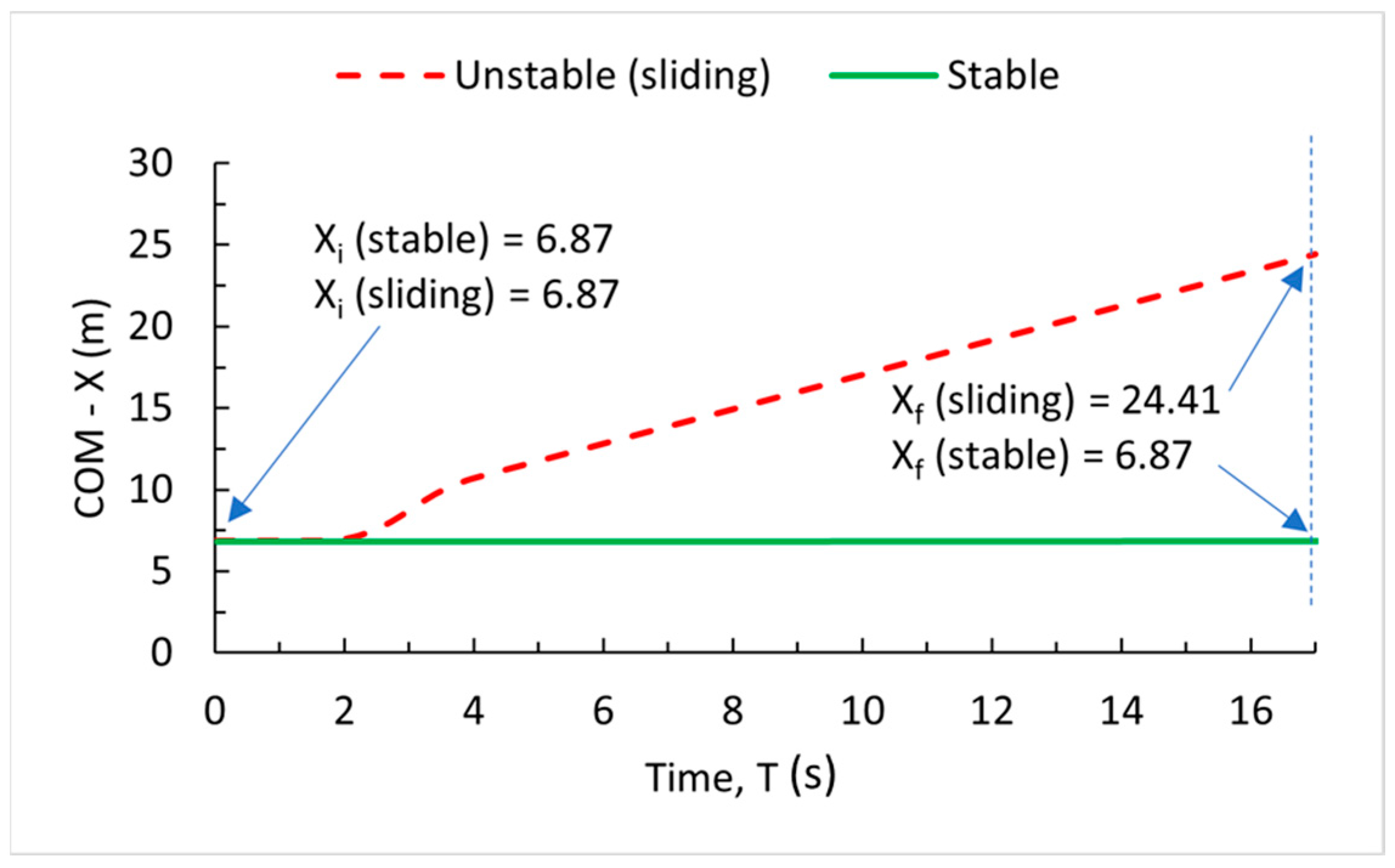
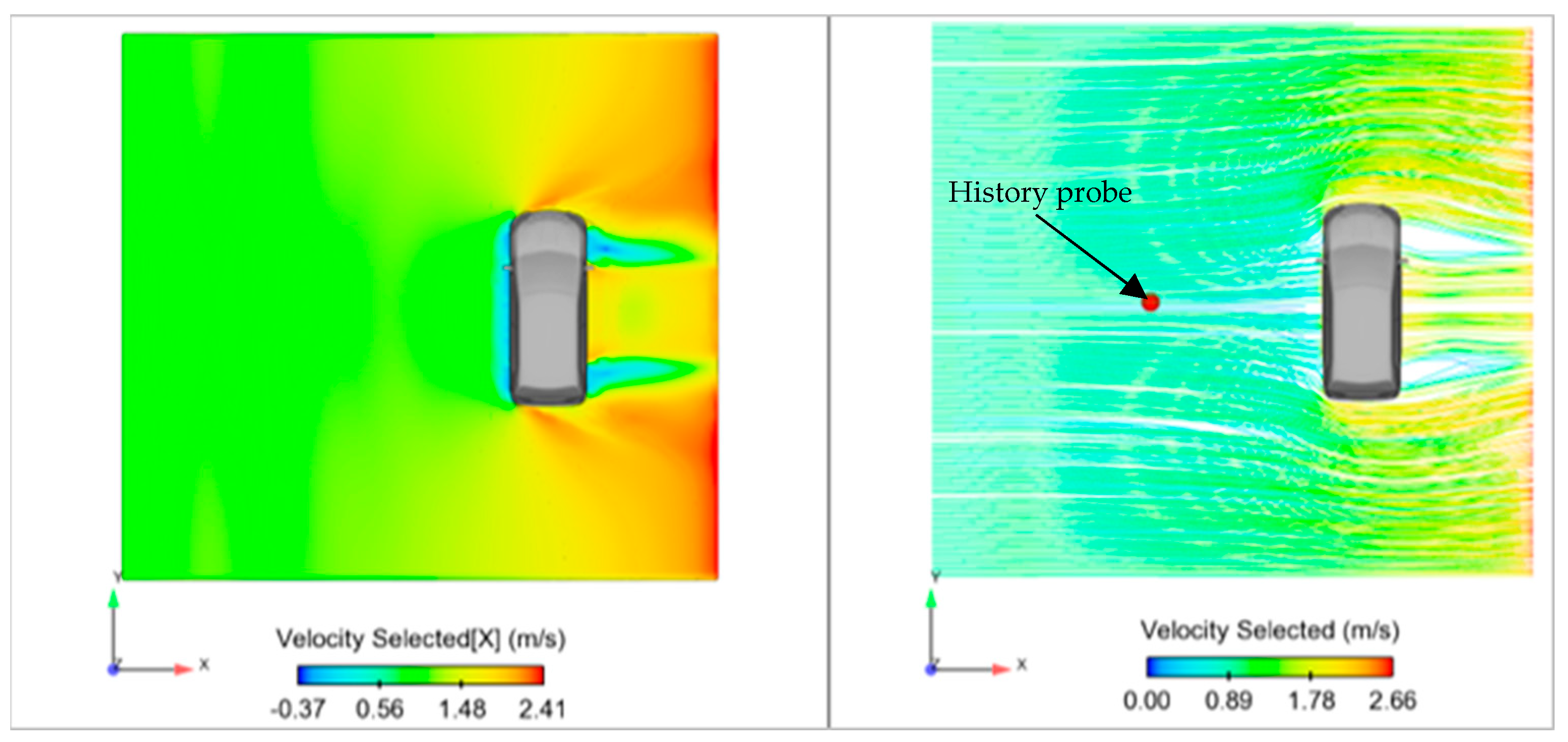





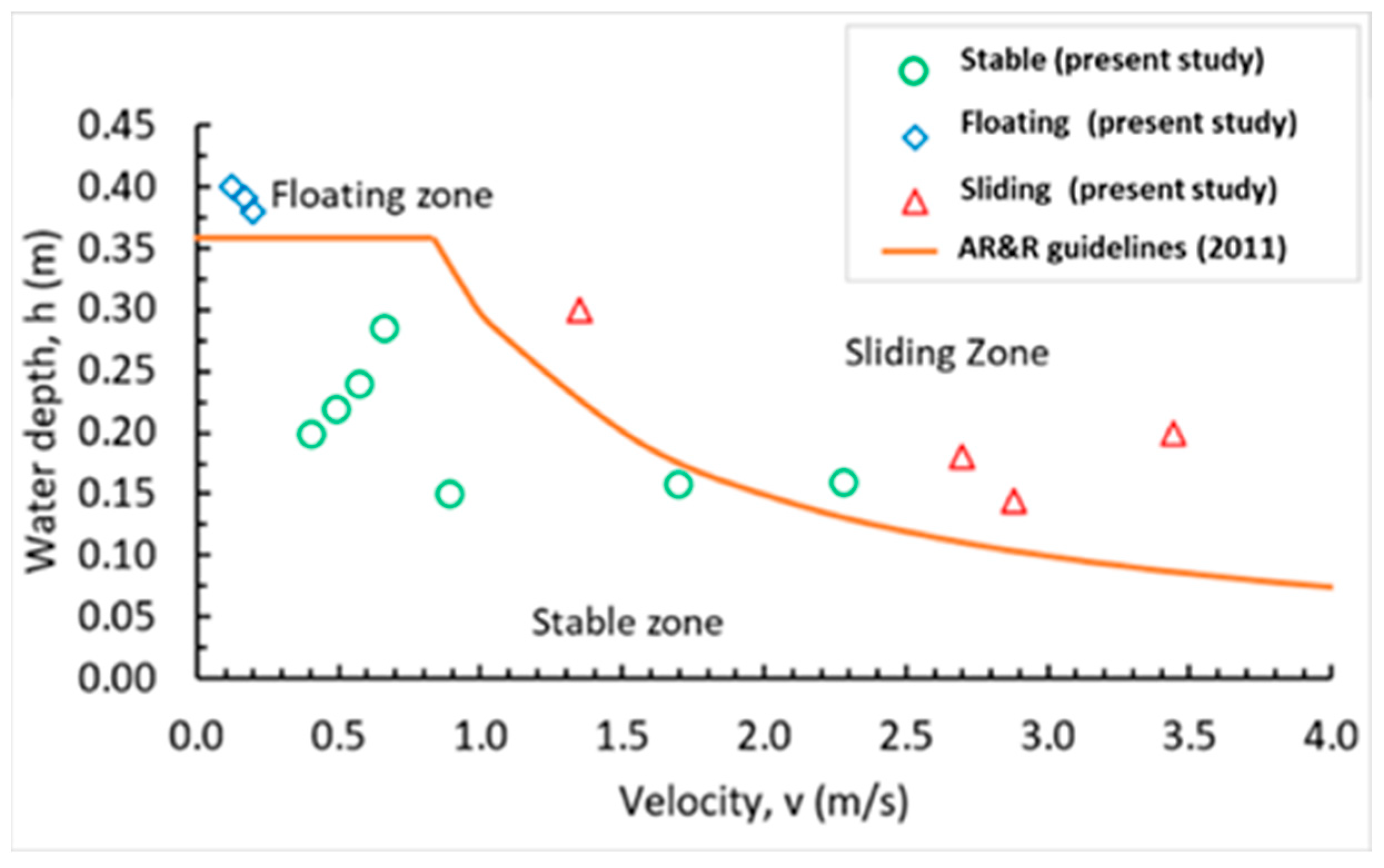
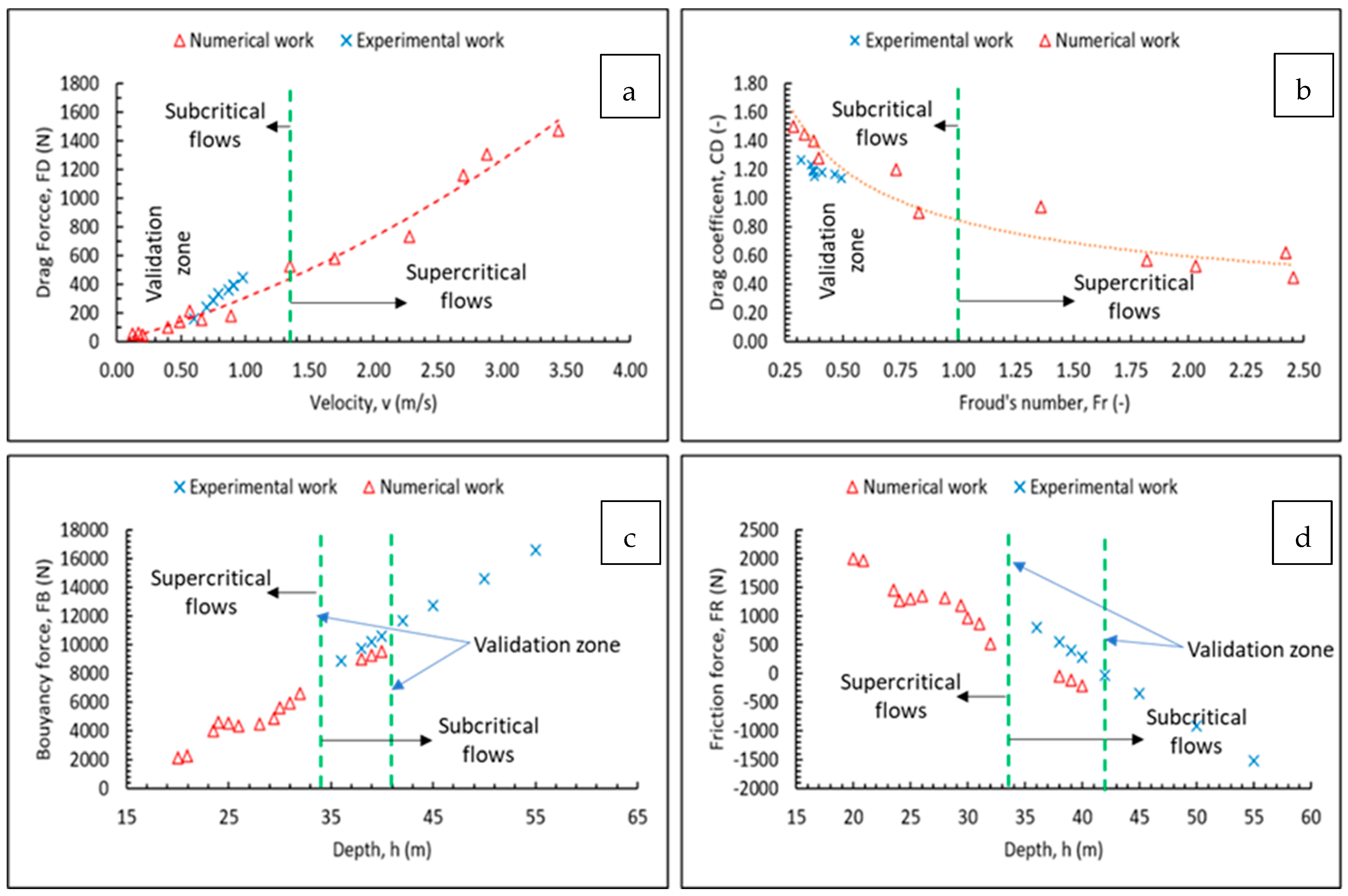
| Cell Size (m) | 0.100 | 0.075 | 0.05 | 0.025 |
| Flow velocity (m/s) | 1.84 | 1.74 | 1.61 | 1.63 |
| Froude number (-) | 1.17 | 1.04 | 0.98 | 0.99 |
| Case | Water Depth 3 m ahead of the Vehicle (m) | Flow Velocity 3 m ahead of the Vehicle (m/s) | Froude Number | Depth beside Vehicle (m) | Vehicle Instability Mode |
|---|---|---|---|---|---|
| 1 | 0.14 | 2.88 | 2.42 | 0.24 | Sliding |
| 2 | 0.15 | 0.89 | 0.37 | 0.20 | Stable |
| 3 | 0.29 | 0.66 | 0.39 | 0.29 | Stable |
| 4 | 0.16 | 1.70 | 1.36 | 0.26 | Stable |
| 5 | 0.16 | 2.28 | 1.82 | 0.28 | Stable |
| 6 | 0.24 | 0.57 | 0.37 | 0.25 | Stable |
| 7 | 0.22 | 0.49 | 0.33 | 0.24 | Stable |
| 8 | 0.20 | 0.40 | 0.28 | 0.21 | Stable |
| 9 | 0.18 | 2.70 | 2.03 | 0.31 | Sliding |
| 10 | 0.20 | 3.44 | 2.46 | 0.30 | Sliding |
| 11 | 0.30 | 1.35 | 0.83 | 0.32 | Sliding |
| 12 | 0.38 | 0.20 | 0.1 | 0.38 | Floating |
| 13 | 0.39 | 0.17 | 0.09 | 0.39 | Floating |
| 14 | 0.40 | 0.12 | 0.12 | 0.40 | Floating |
Disclaimer/Publisher’s Note: The statements, opinions and data contained in all publications are solely those of the individual author(s) and contributor(s) and not of MDPI and/or the editor(s). MDPI and/or the editor(s) disclaim responsibility for any injury to people or property resulting from any ideas, methods, instructions or products referred to in the content. |
© 2023 by the authors. Licensee MDPI, Basel, Switzerland. This article is an open access article distributed under the terms and conditions of the Creative Commons Attribution (CC BY) license (https://creativecommons.org/licenses/by/4.0/).
Share and Cite
Al-Qadami, E.H.H.; Razi, M.A.M.; Damanik, W.S.; Mustaffa, Z.; Martinez-Gomariz, E. Understanding the Stability of Passenger Vehicles Exposed to Water Flows through 3D CFD Modelling. Sustainability 2023, 15, 13262. https://doi.org/10.3390/su151713262
Al-Qadami EHH, Razi MAM, Damanik WS, Mustaffa Z, Martinez-Gomariz E. Understanding the Stability of Passenger Vehicles Exposed to Water Flows through 3D CFD Modelling. Sustainability. 2023; 15(17):13262. https://doi.org/10.3390/su151713262
Chicago/Turabian StyleAl-Qadami, Ebrahim Hamid Hussein, Mohd Adib Mohammad Razi, Wawan Septiawan Damanik, Zahiraniza Mustaffa, and Eduardo Martinez-Gomariz. 2023. "Understanding the Stability of Passenger Vehicles Exposed to Water Flows through 3D CFD Modelling" Sustainability 15, no. 17: 13262. https://doi.org/10.3390/su151713262





